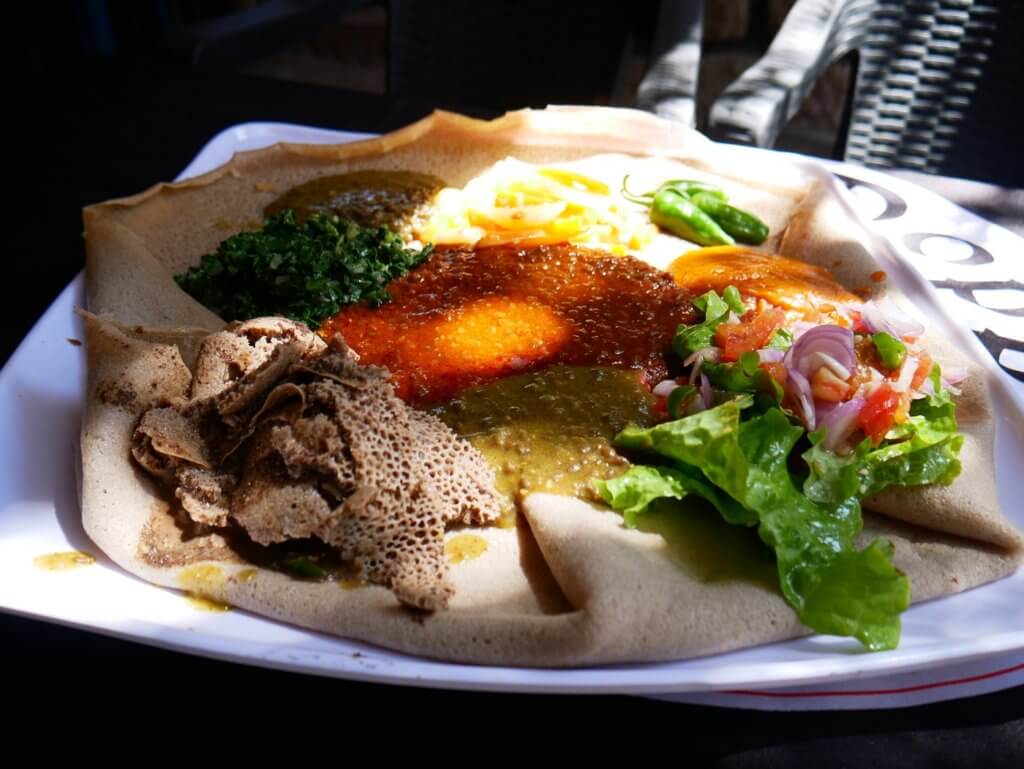
As a traveling vegetarian, Ethiopia is quite an easy country to visit. Many national dishes are vegetarian or vegan. These are the Ethiopian food and drinks I wolfed down during my one-month stay in Addis Ababa, Bahir Dar, and Lalibela.
Contents
- 1 How to Find Out Which Ethiopian Foods are Vegetarian?
- 2 Ethiopian Food and Drink Diary
- 2.1 Arrival in Addis Ababa (Thursday, January 26th)
- 2.2 The first beyaynetu at Kategna (Friday, January 27th)
- 2.3 Yemeni food (Saturday, January 28th)
- 2.4 Yetem delivery food (Sunday, January 29th)
- 2.5 Indian food (Monday, January 30th)
- 2.6 Roadside restaurant (Tuesday, January 31st)
- 2.7 Hotel breakfast + supermarket visit (Wednesday, February 1st)
- 2.8 Three magical stews (Thursday, February 2nd)
- 3 Ethiopian Coffee Ceremony
- 4 Helpful? Please consider buying me a flaxseed juice!
- 5 Spread your love for Ethiopian food
How to Find Out Which Ethiopian Foods are Vegetarian?
Ever since the start of our journey of learning about Ethiopian food, we’ve used this handy glossary to figure out what’s what. I use ctrl + F or page search to find out which dishes are veg. We basically started with the beyayenetu (በያይነቱ – meaning ‘variety’), which is vegetarian unless otherwise specified, and then expanded our knowledge from there. In my experience, using the word vejeteriyani or ቬጀቴሪያን does not work on people who don’t know English.
As a rule, all food in traditional restaurants in Ethiopia is vegetarian on Wednesdays and Fridays. These two days of the week are always fasting (ts’om – ጾመ) days, and fasting means no meat, no egg, no dairy, and no butter (though honey is okay). Sometimes people eat fish on those days, which is allowed, but you tend to not get fish served on fasting days randomly without specifying. Unfortunately, there is a prejudice that (white) foreigners are passionate meat eaters, so in some restaurants on non-fasting days, people will try to get you to eat the meat. They might be confused when you don’t want to eat meat since most Ethiopians do eat heaps of meat whenever it’s not a fasting day.
The number of fasting days in the Ethiopian calendar totals 250 days out of 365. You can see that fasting only on Wednesdays and Fridays don’t add up to 250. That is because there are many more fasting days, including the 55 days before Easter (fasika – ፋሲካ) and some less famous fasting days. It’s a lot.
Ethiopian Food and Drink Diary
Ethiopian Coffee Ceremony
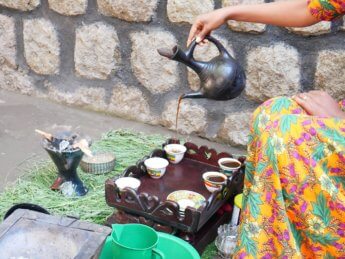
No popcorn, just popcorn
In the UAE and in Turkiye, we have already experienced the Ethiopian coffee ceremony. Over there, it was quite standard that we’d receive a full jebena (coffee pot) with three small cups, a pot of sugar, lightly-salted popcorn, and a heap of smoking incense that mystifies the room.
In Ethiopia, we’ve had single cups of coffee without much fanfare in many places, from alcohol shops to museum cafés. In Bahir Dar, we finally had the incense with the coffee at Coffee Hub. But no popcorn! Had I imagined the popcorn? Was I going crazy?
The next step is of course to use Google Translate. Google says popcorn is fanidīsha or ፋንዲሻ. The glossary says it’s fandisha or ፈንዲሻ. Either way, when we started asking for this, everyone still shook their heads. Is it not popcorn season? Is it not traditional? I am clueless and I left space in my tummy for nothing.
Full coffee ceremony at Alem Restaurant, Lalibela
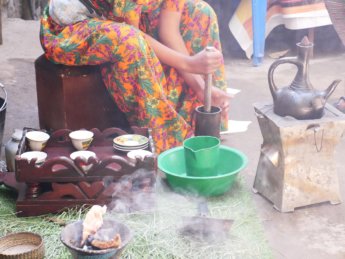
After the cooking class, one of the women of Alem Restaurant started preparing the coffee while we were eating. She roasted the green coffee beans in a flat pan and brought them to us to sniff after roasting. It smelt marvelous.
She then spent about 20 minutes grinding the coffee by hand in a metal cup with a metal bar. It looked like quite a tough job and I would have loved to have crushed some beans myself if I hadn’t been fingers-deep in my self-made beyaynetu.
By the time we were full, the coffee was ground into a fine powder, like Turkish coffee. She rinsed out the jebena before dropping a couple of teaspoons went into the narrow top. The coffee process had begun.
Some coals went from the fire she was feeding ar with a leathery fan into a tall pot to start the incense. A colorful confetti went on top of the burning coals and the smoke screen started. Again, the smells were amazing.
She washed three cups in a bucket and filled them up with a generous amount of sugar. Alem asked if we wanted sugar, to which we said we’d rather not. The sugar was cleaned out and then the woman poured the fresh and hot coffee into the small cups (sini ሲኒ.) from a considerable height. I received the first one and thanked her, Jonas the second, and Alem the third. Alem told us the name of this first cup of coffee is abol (አቦል) and it is the strongest.
This was an excellent opportunity to ask all my dumb questions, so I asked why the cups are always filled to the edge and not to the thin line inside the cup, and as somewhat anticipated, it’s a hospitality and generosity thing. I asked her at what age she started drinking coffee, and she said at about 15. Kind of the same age when I started experimenting with caffeine. And lastly, I asked about the fresh grass on the floor and around the coffee table (rekebot ረከቦት). This was also a cozy and welcoming thing. People harvest grass outside the city to make their homes a place for guests.
We asked about the popcorn (fandisha) thing, and Alem said that the traditional snack for the coffee ceremony is something she called tereq injera (in the glossary it’s called dirkosh ድርቆሽ). It’s basically dried injera chips. Just plain, no seasoning. It’s also an excellent way to bring some injera home because it stays good for several months if kept very dry (not in the fridge) to let friends and family have a taste of real injera. It can be rehydrated and used in fitfit too. Alem’s sister, who lives somewhere in the Netherlands, sometimes takes this home.
But we were talking about popcorn. Alem said this is more of a recent tradition. We told her we had it everywhere in Ethiopian restaurants abroad and it would be lightly salted. She said it’s a bit sweetened here and asked if we wanted any. Yes! Absolutely.
It was time for the second cup of coffee called tona (ቶና, or hulatona ሁላጦና in the glossary). The same coffee grounds in the jebena are reused for this process, which makes it a bit less strong.
The popcorn arrived when it was time for the third traditional cup of coffee called baraka (bereka በረካ). Since this is the third and last time these coffee grounds are used, it’s not strong at all and has a very mild flavor. I asked at what age kids start drinking this, and Alem said that her four-year-old child would sometimes ask for a cup already, with lots of sugar, of course. Kids are then zooming around on a sugar high all day.
At the end of the coffee ceremony, we thanked the host and Alem. Then it was time to return to our hotel with our two boxes of leftover beyaynetu. This was a truly amazing experience and cleared up so many questions I had.
Introduction to Tana Adam
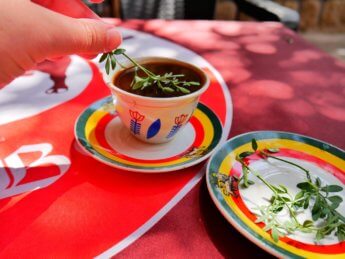
On a visit to Lalibela market (every Saturday), Mas introduced us to tana Adam or t’ena Adam, which is also known as rue or herb-of-grace. I’d never heard of it before this day. Mas said you swirl around this herb in your coffee to give it an extra magnificent taste. We bought some to bring to Bisrat Café to give to the lady.
Mas told us to be careful to not put the herb in the coffee too long, but I couldn’t taste it by just dipping it twice. I had to swirl it around a bunch of times before could taste a flavor that’s like herby and florally and meant for sweet stuff.
A few days later, we had coffee at Alem Restaurant again and I recognized a bundle of tana Adam on the rekebot. When the coffee arrived, I asked for it and it was immediately understood. I feel like I’m finally getting the hang of this!
Popcorn!
Toward the end of our stay in Lalibela, we went to the famed Ben Abeba Restaurant with its magnificent architecture and sunset view. Guess what was offered to us right upon entry? That’s right, lightly-salted popcorn next to the rekebot and jebena. On a later visit, we had the coffee there with the popcorn without us asking for it, but no smoke. Anyway, I think we’ve done it.

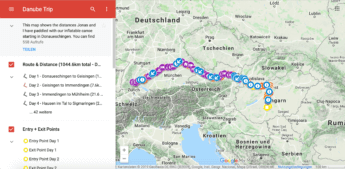
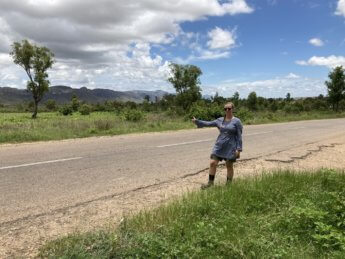


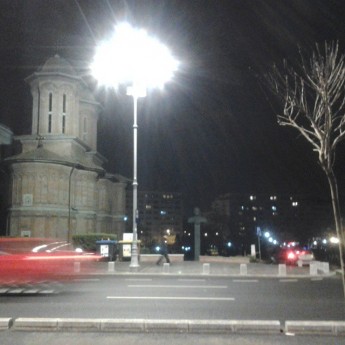
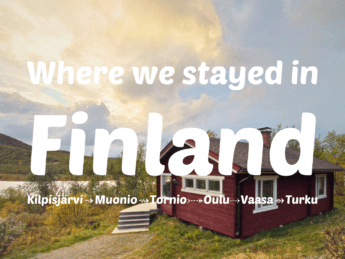






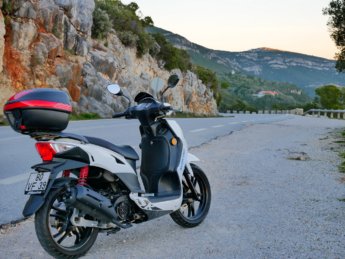

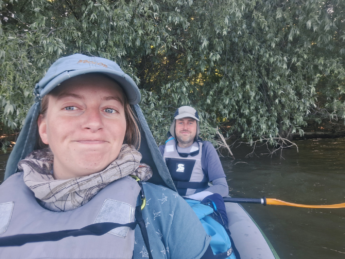



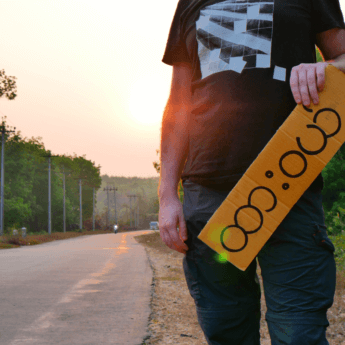

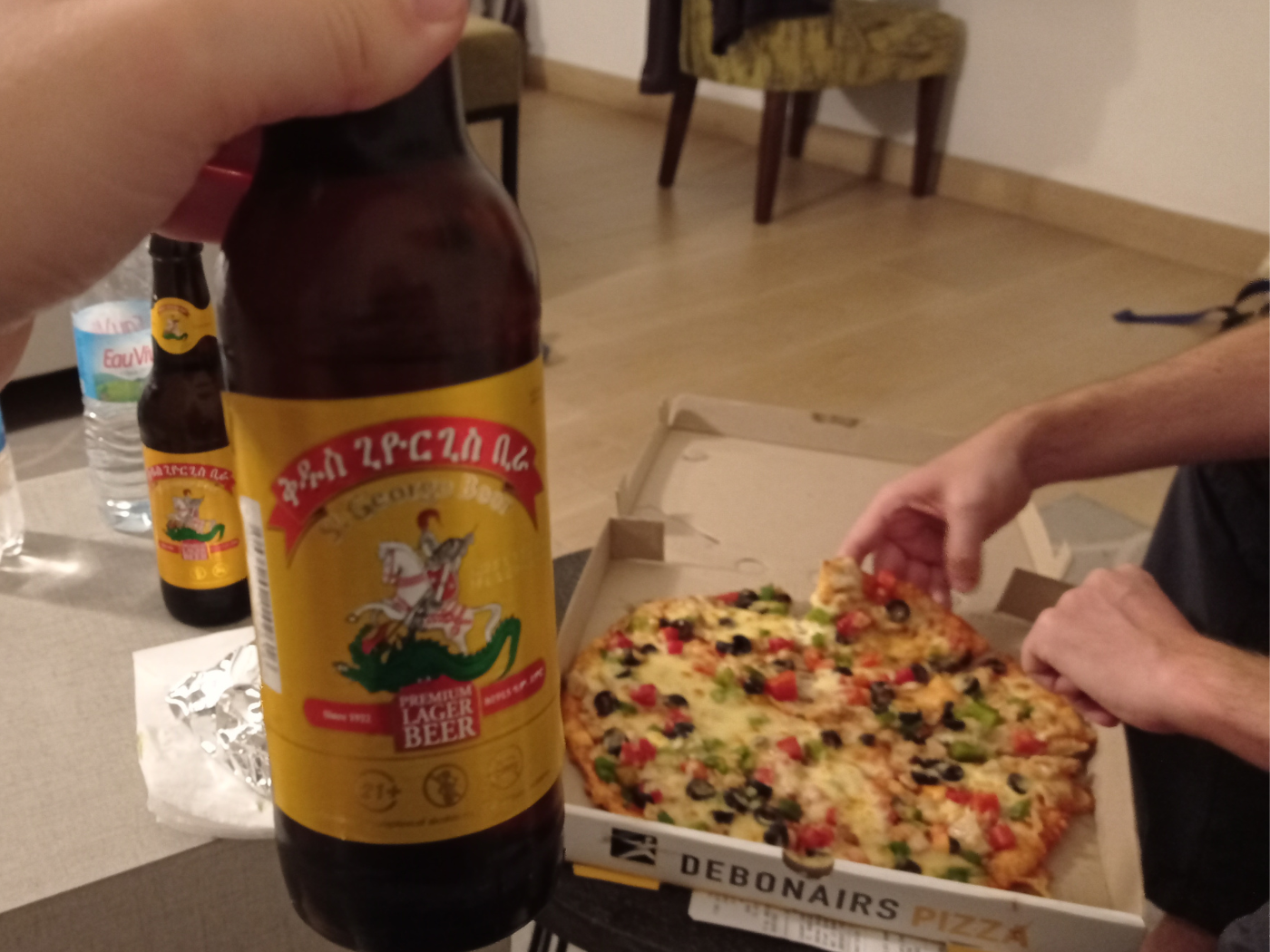
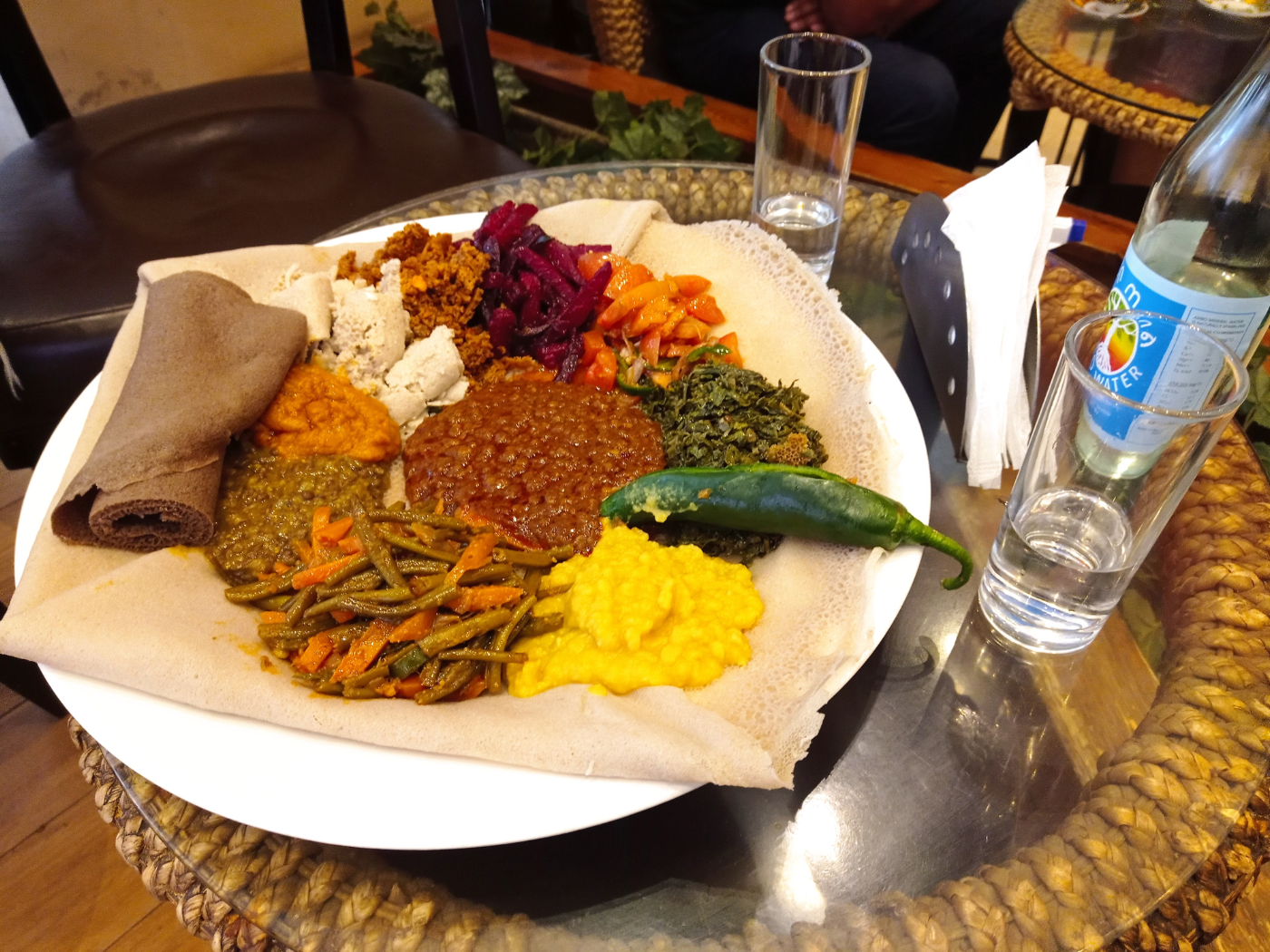

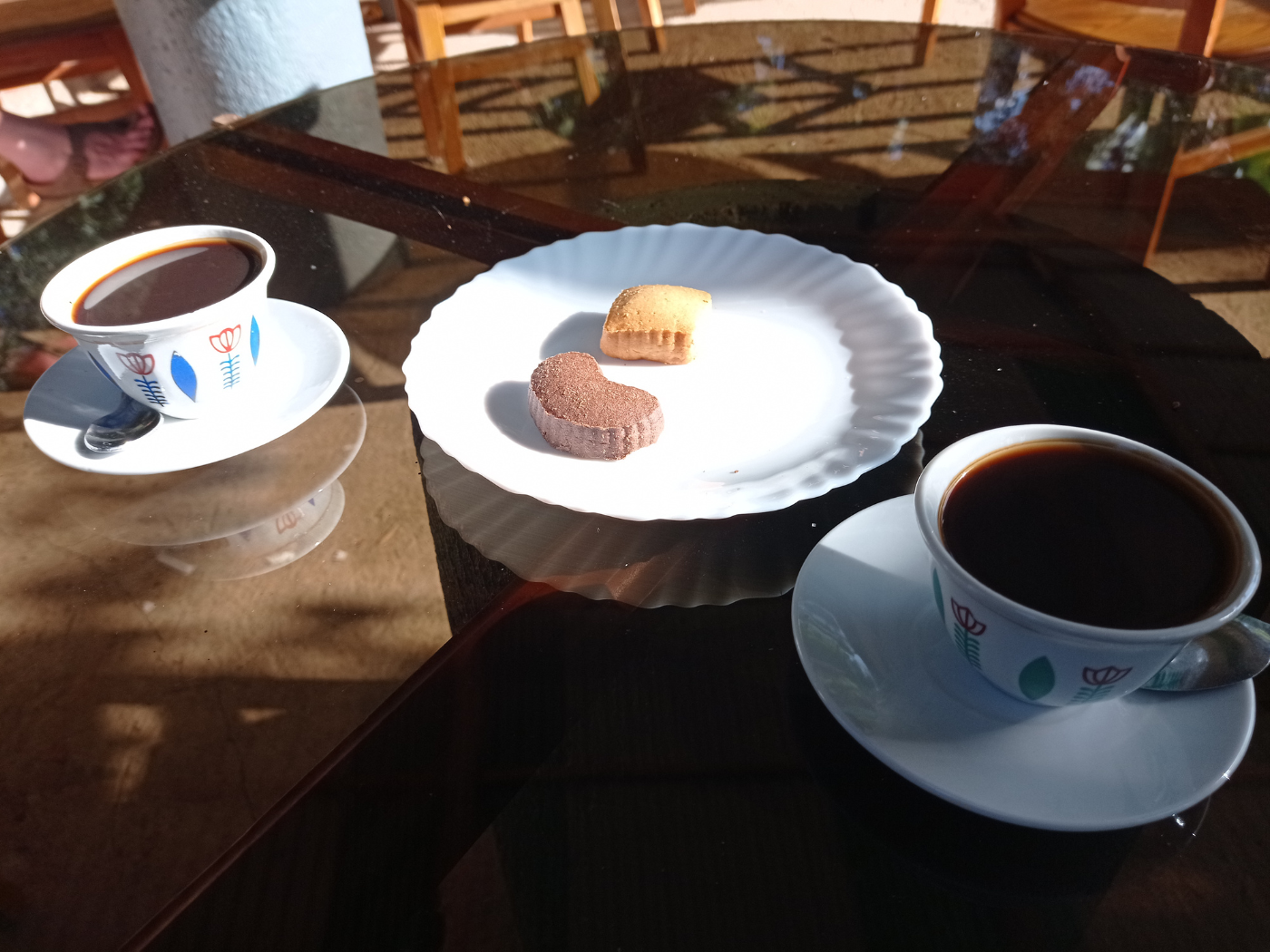
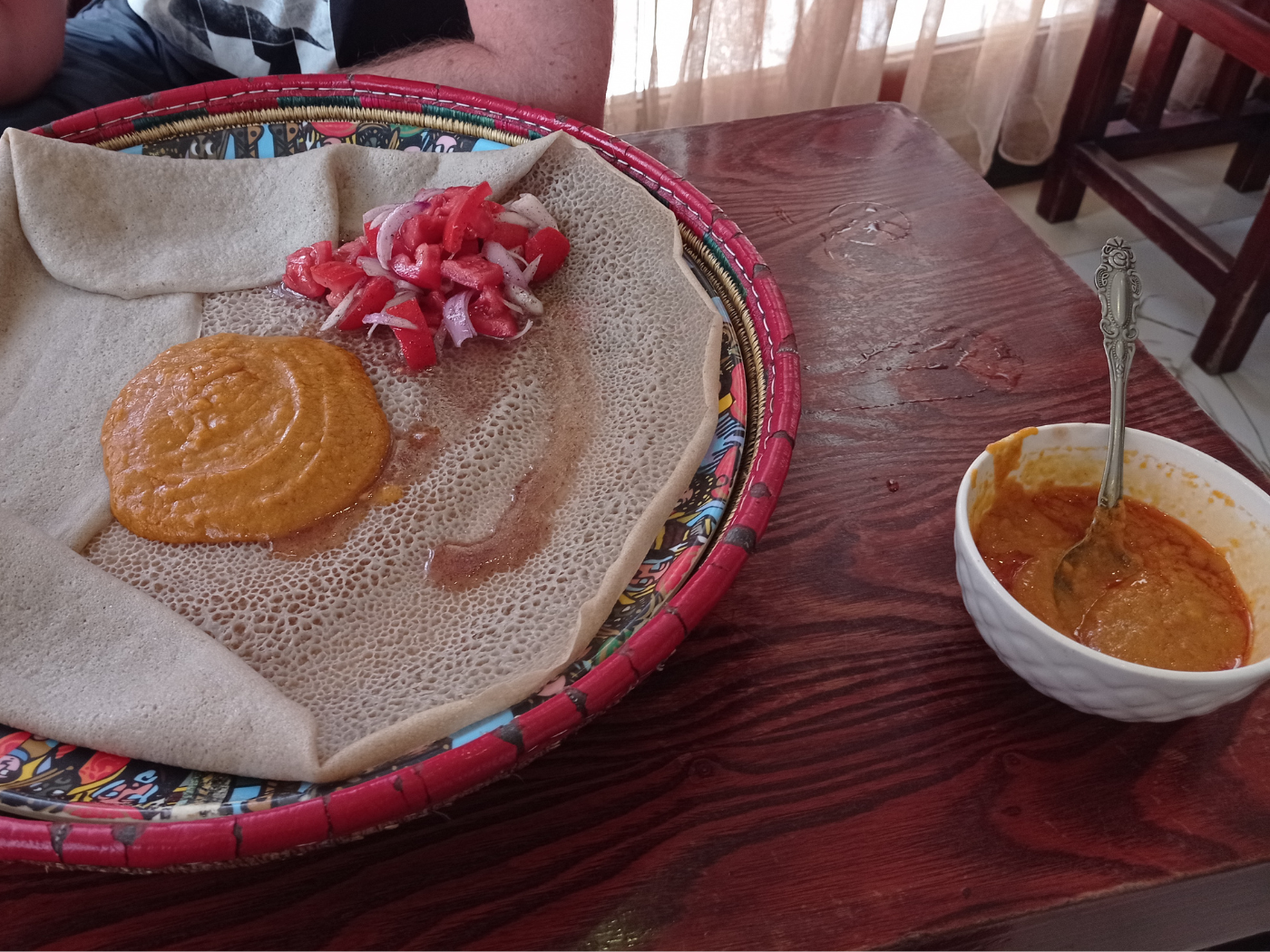
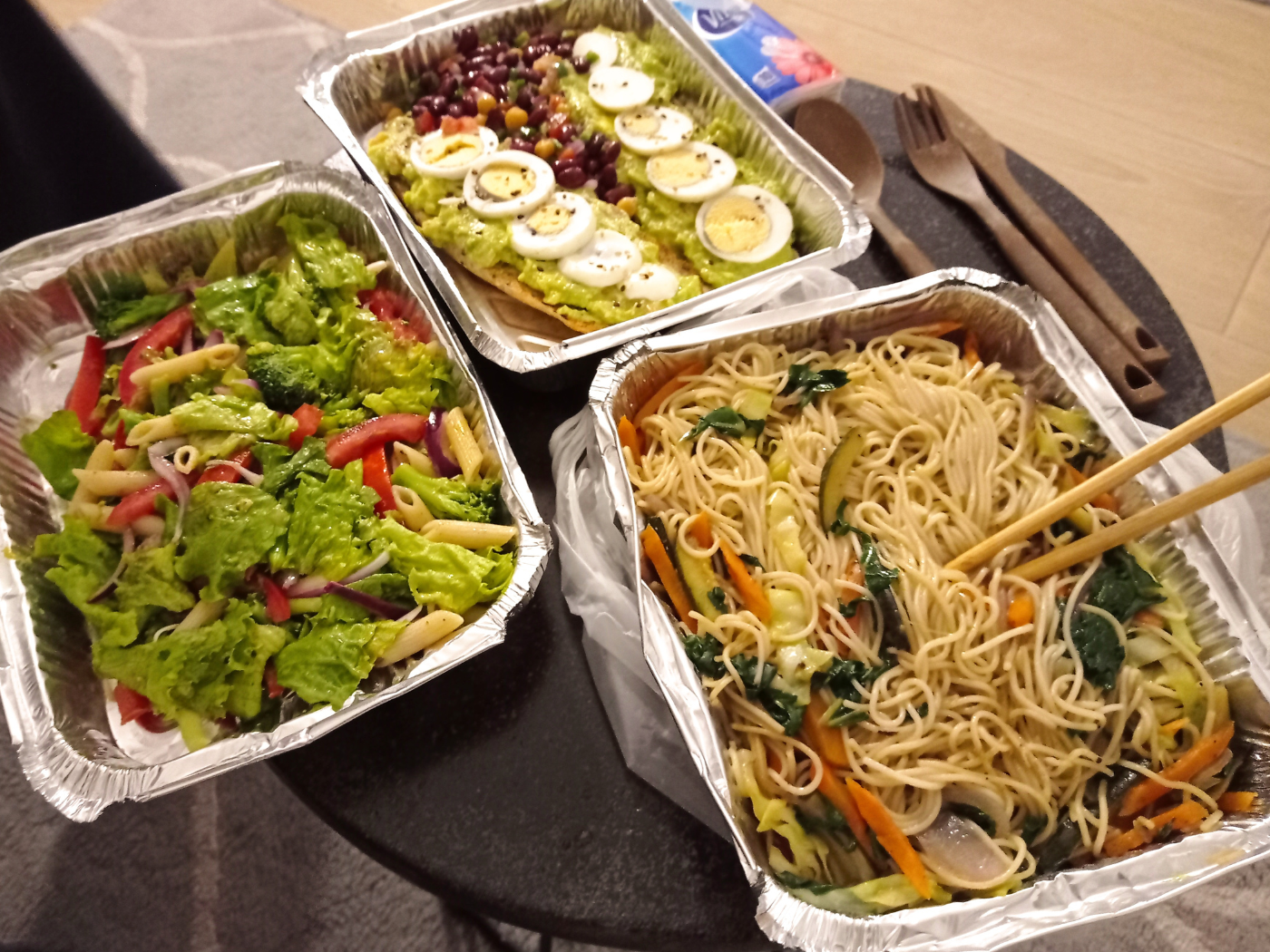
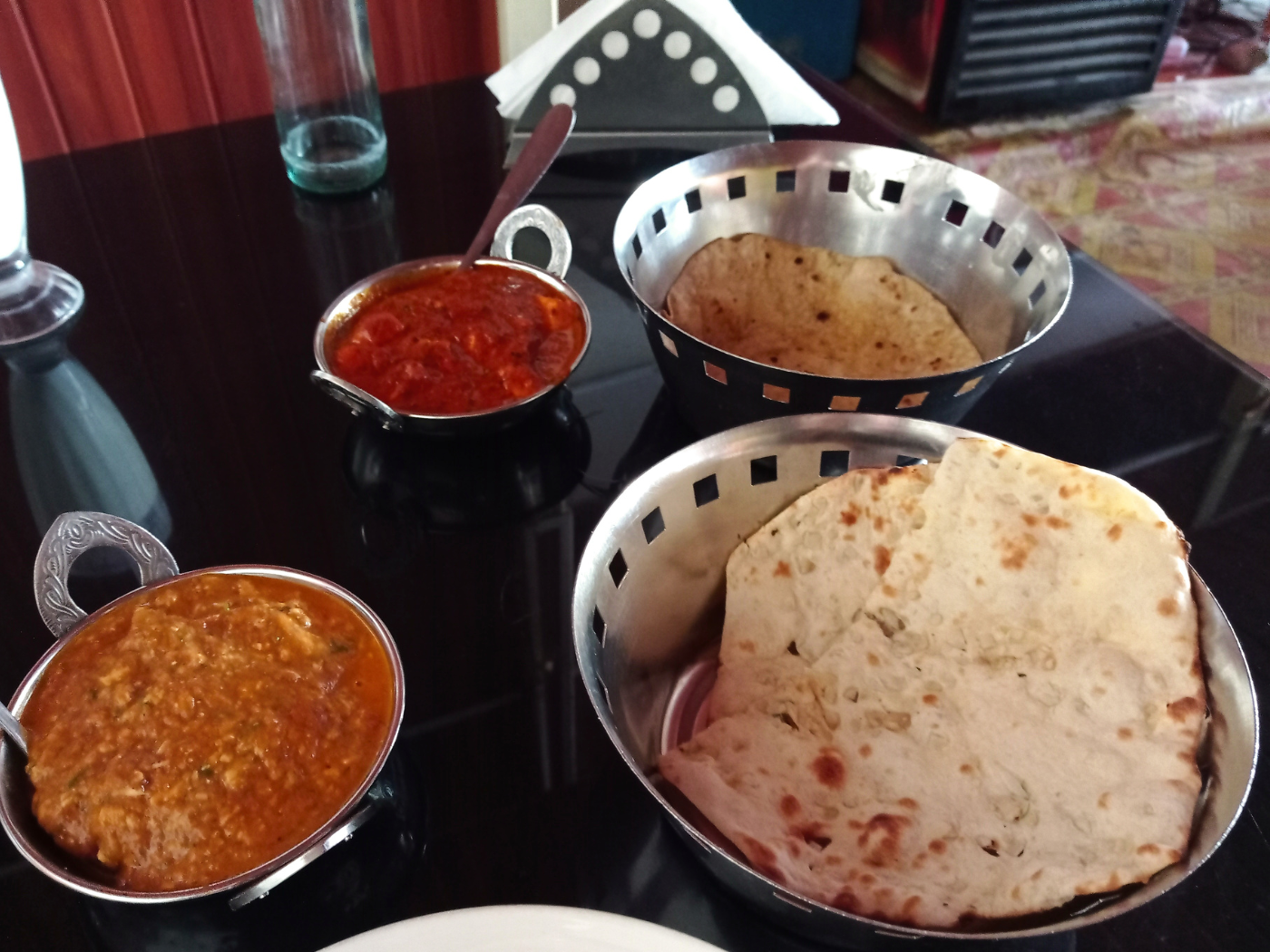
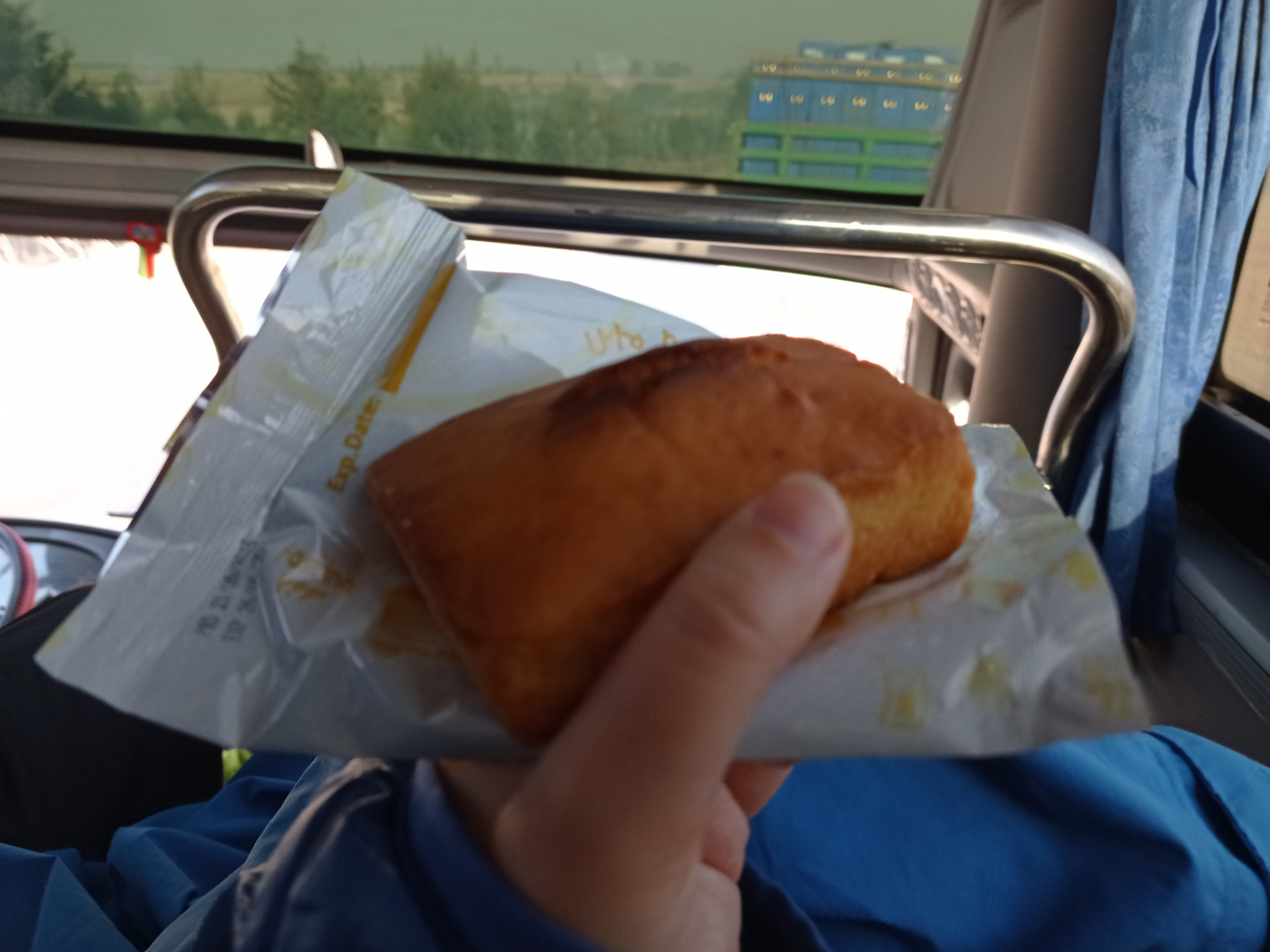
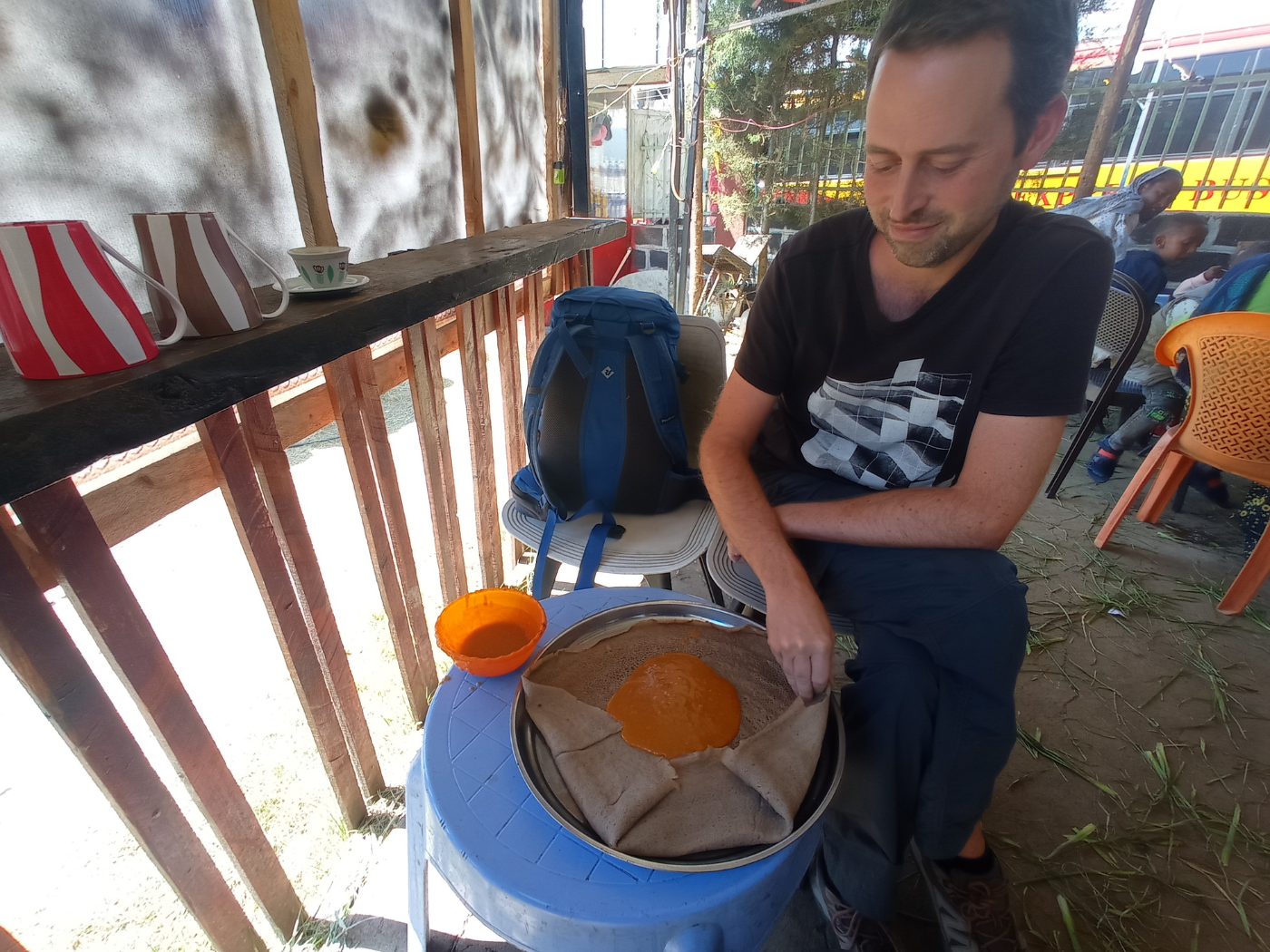
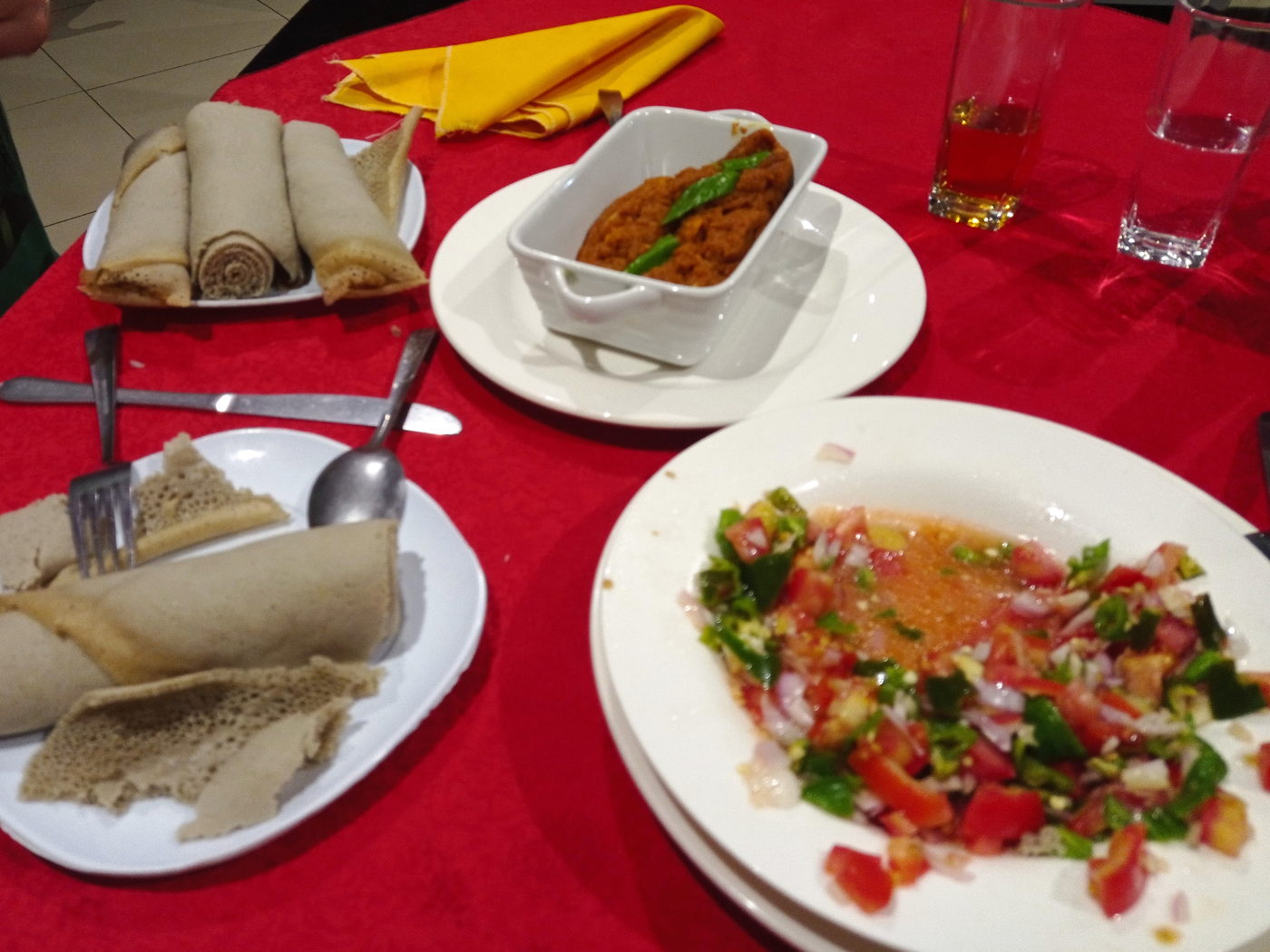
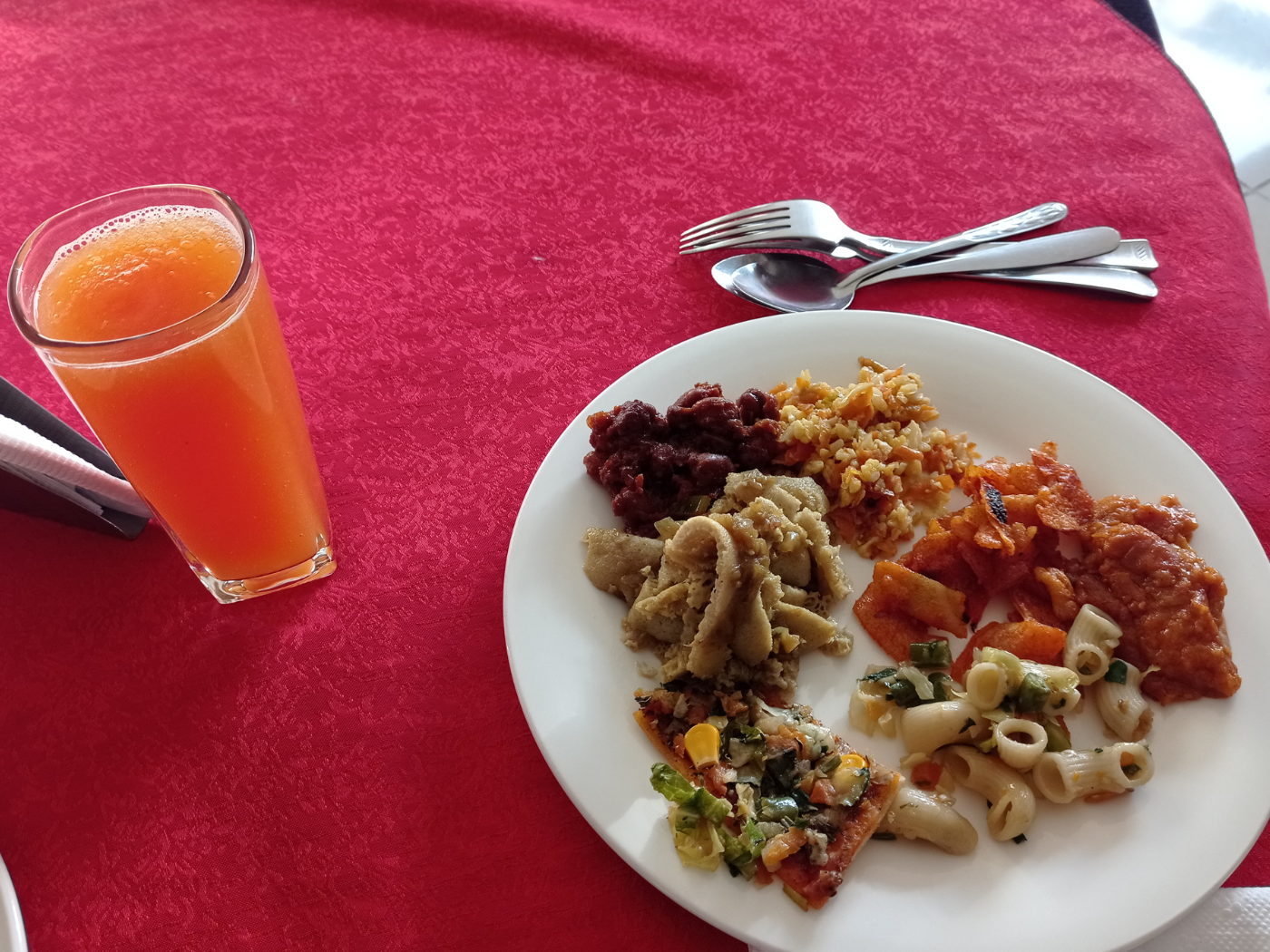
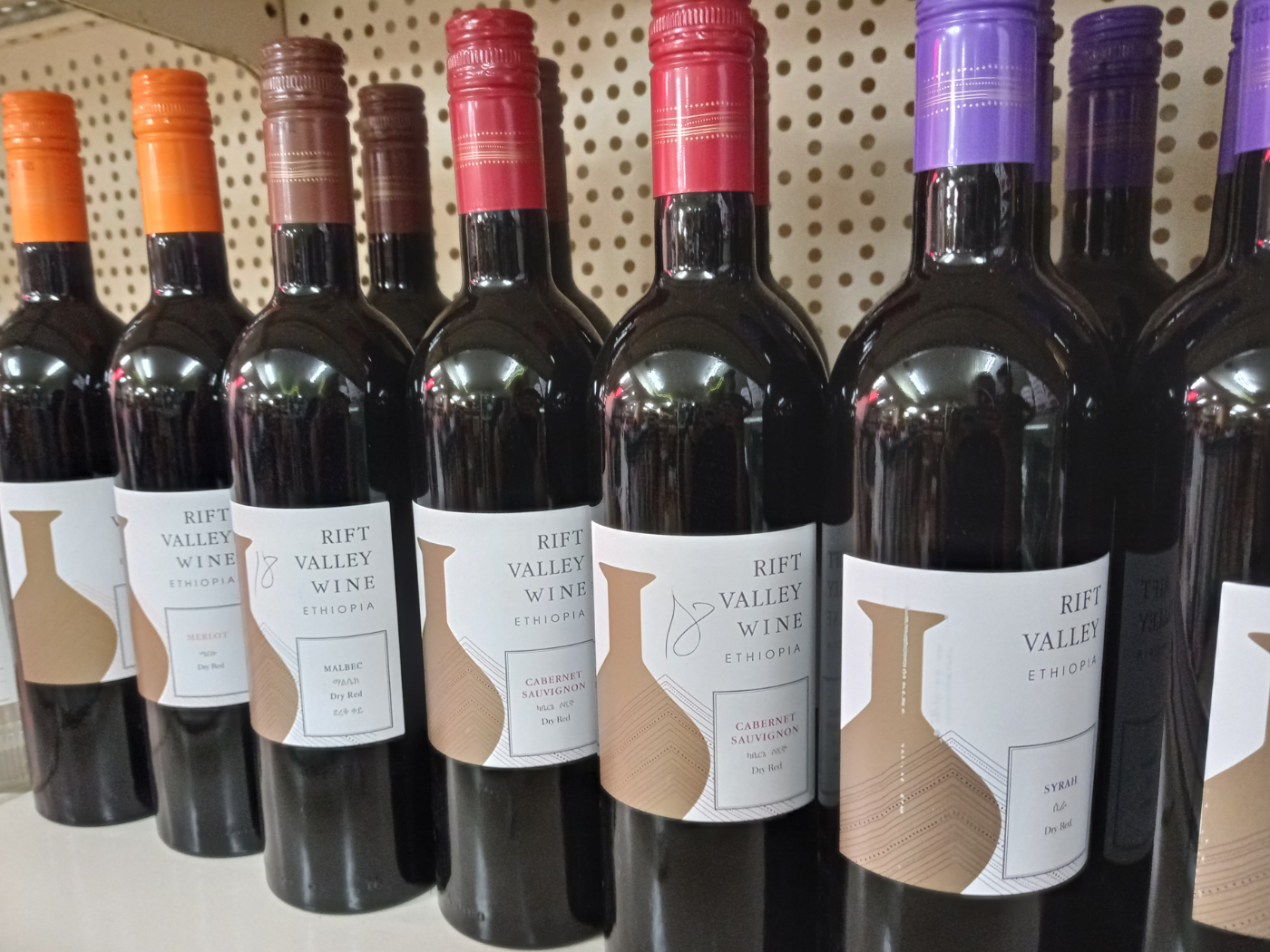
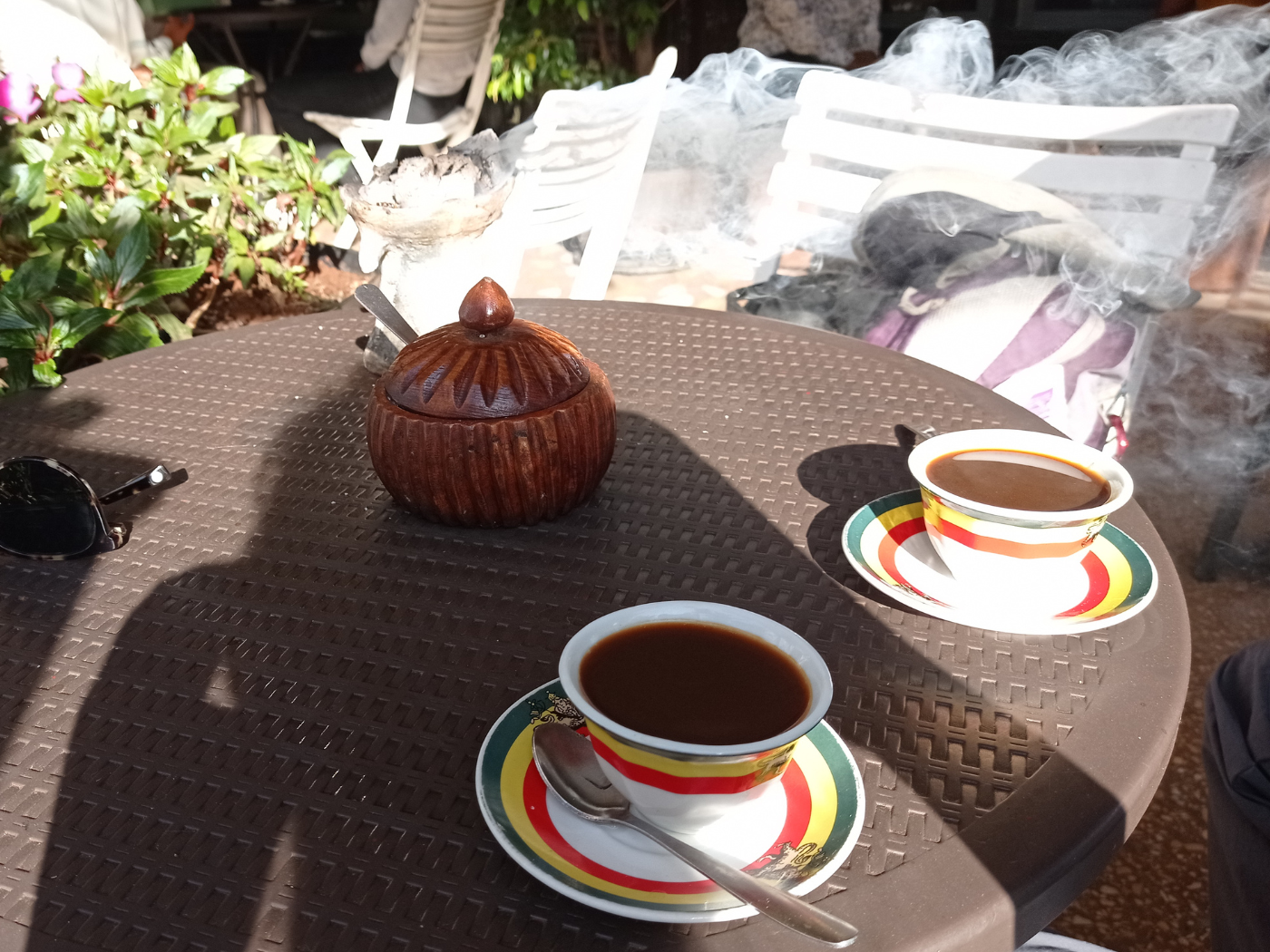
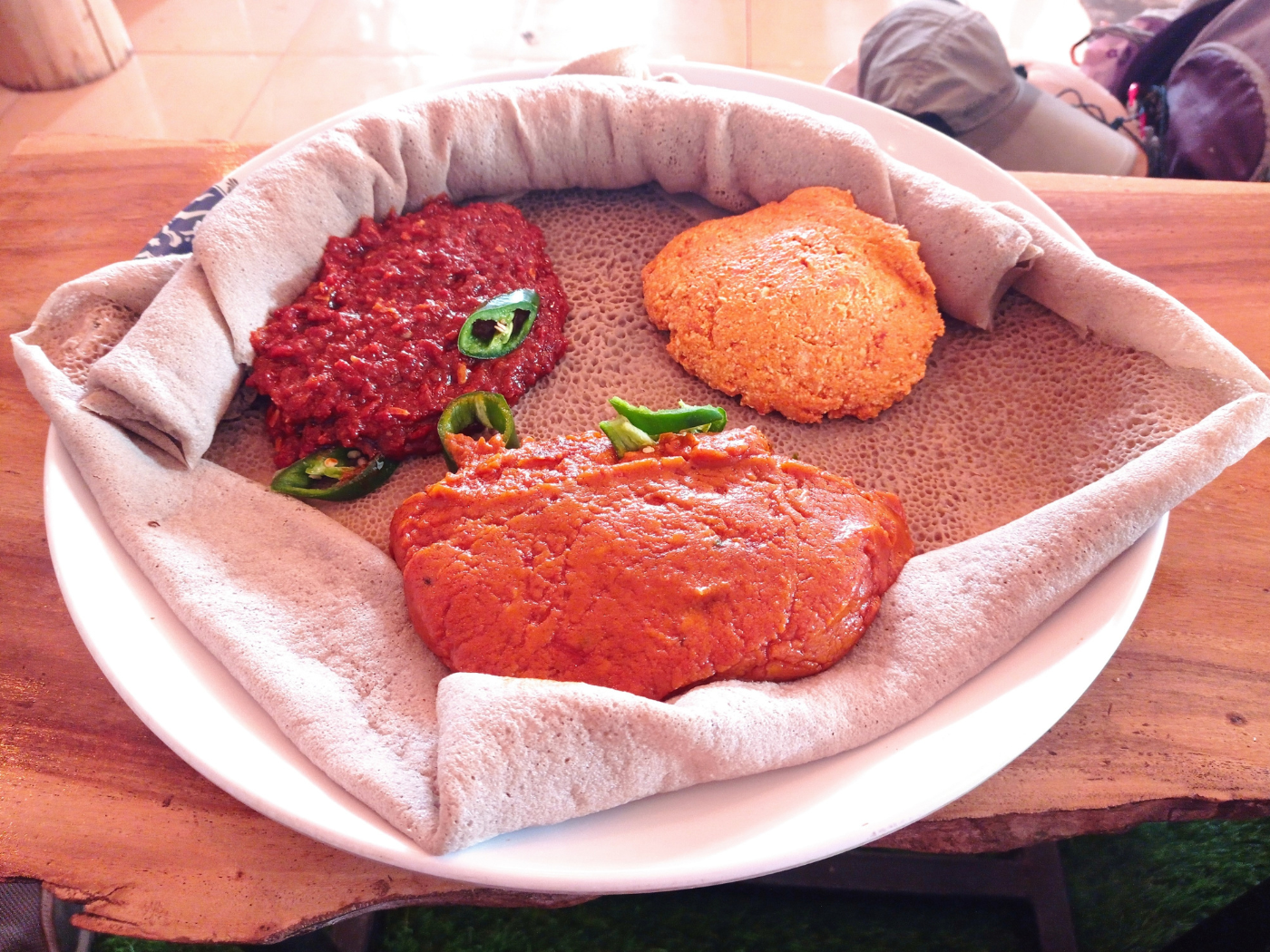

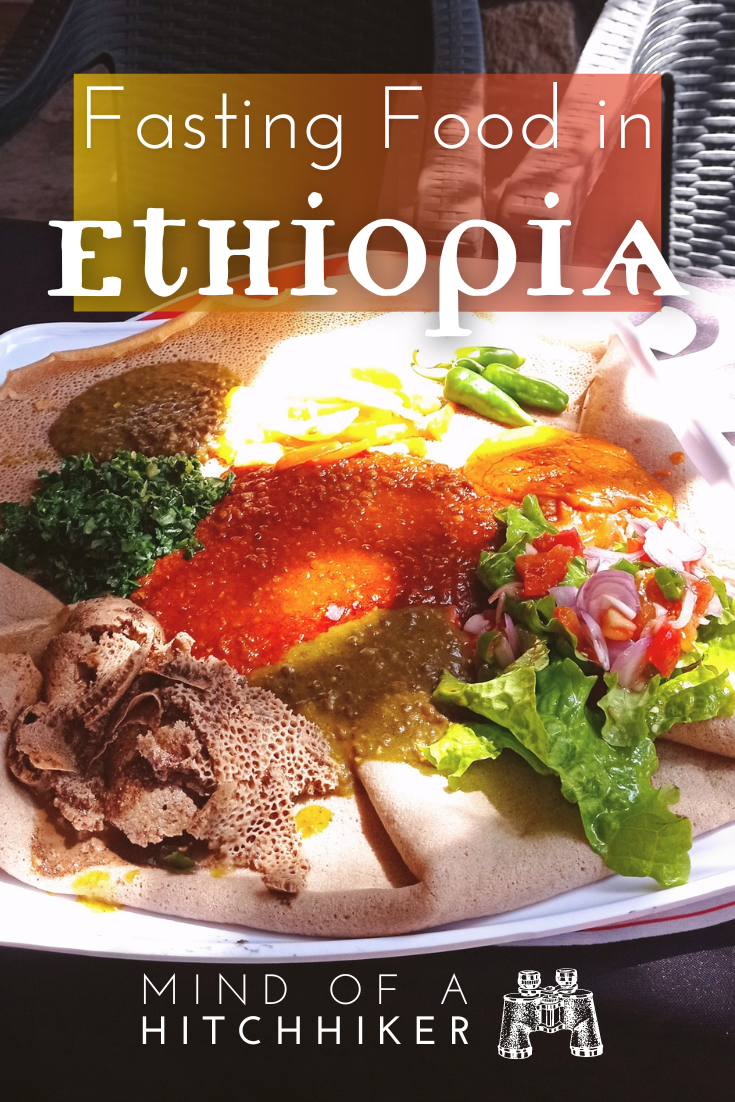
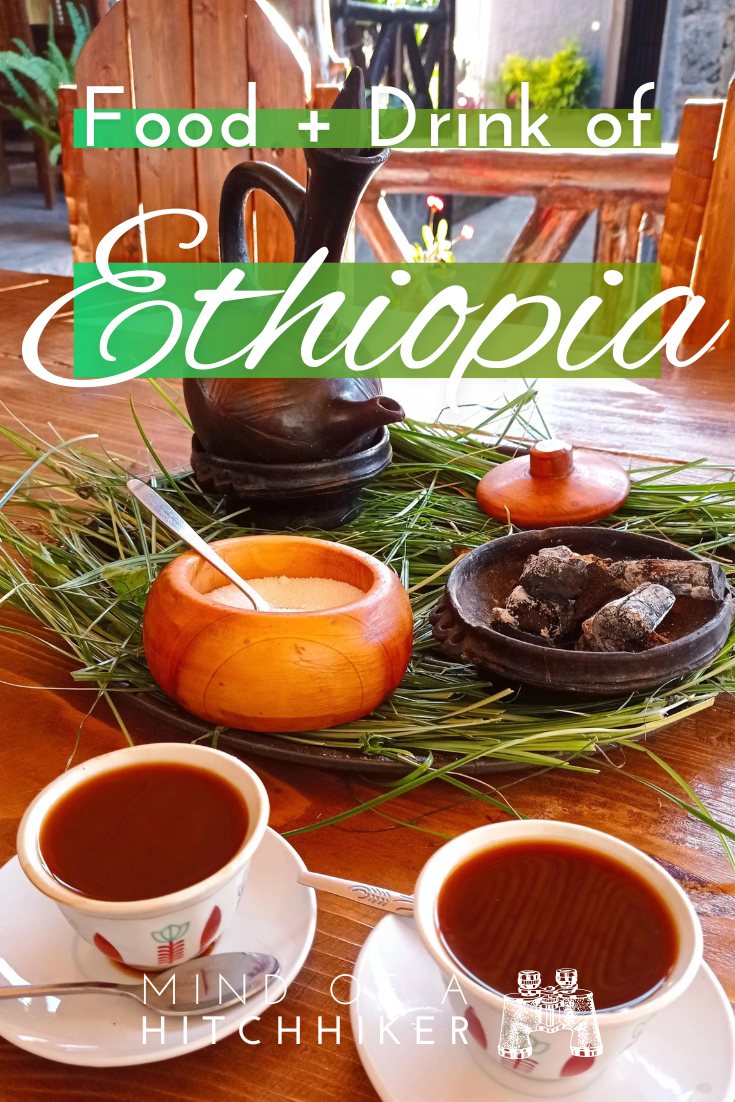
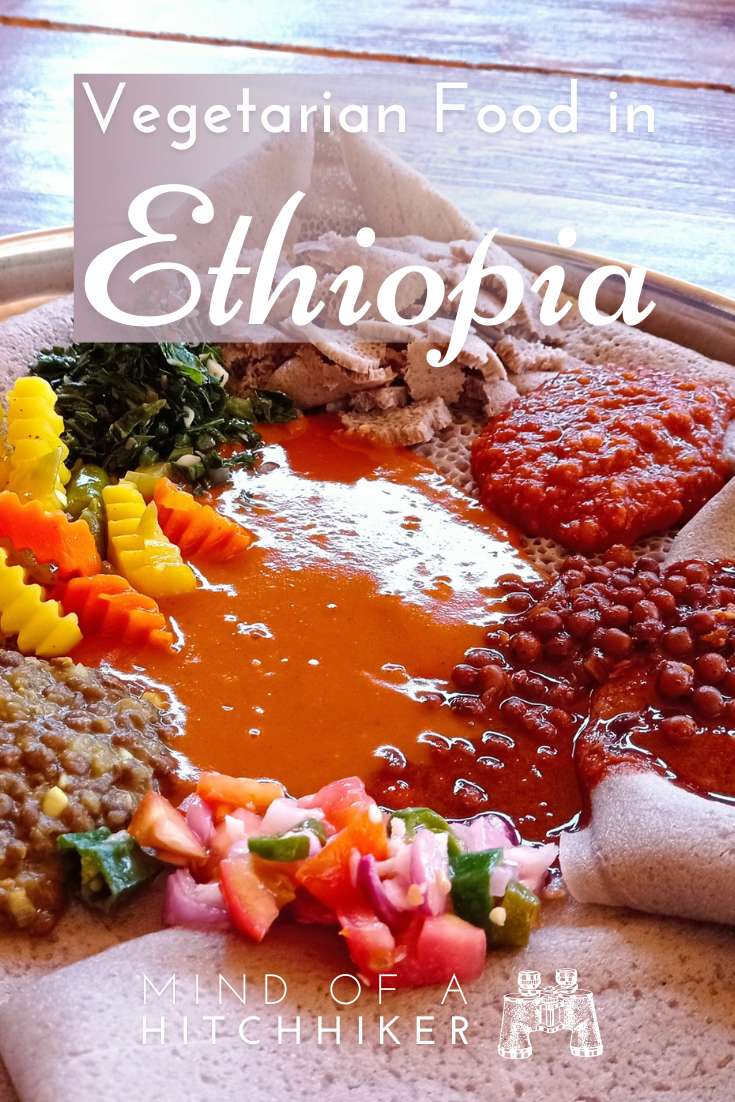
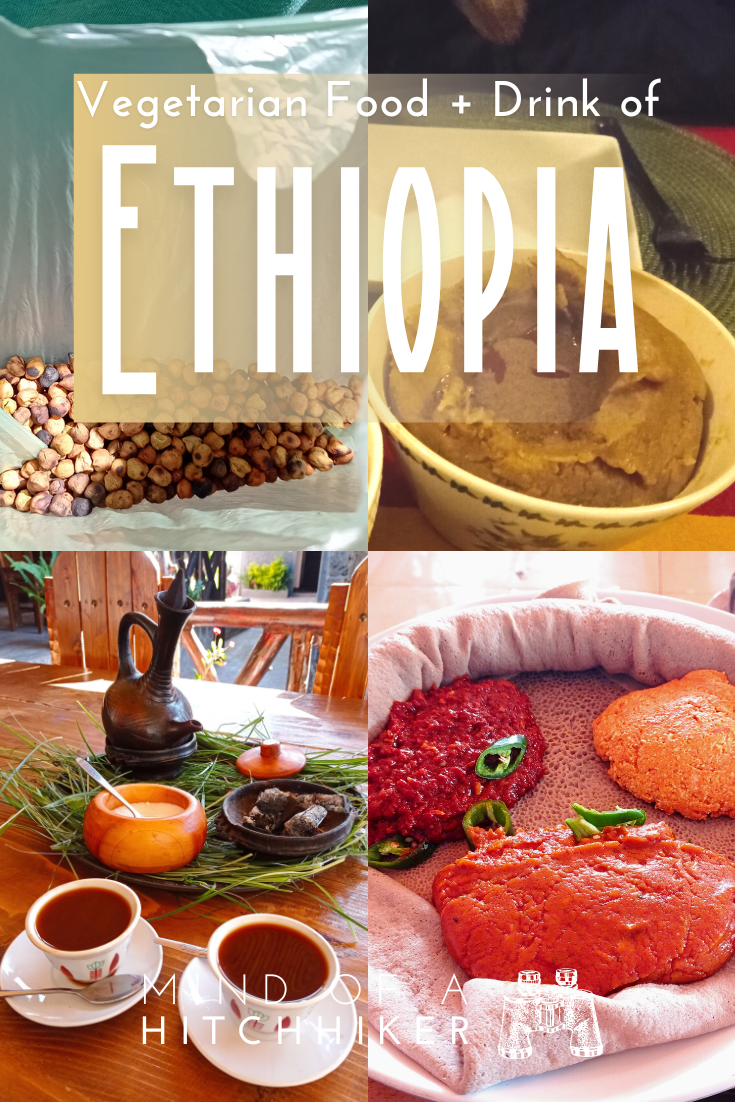
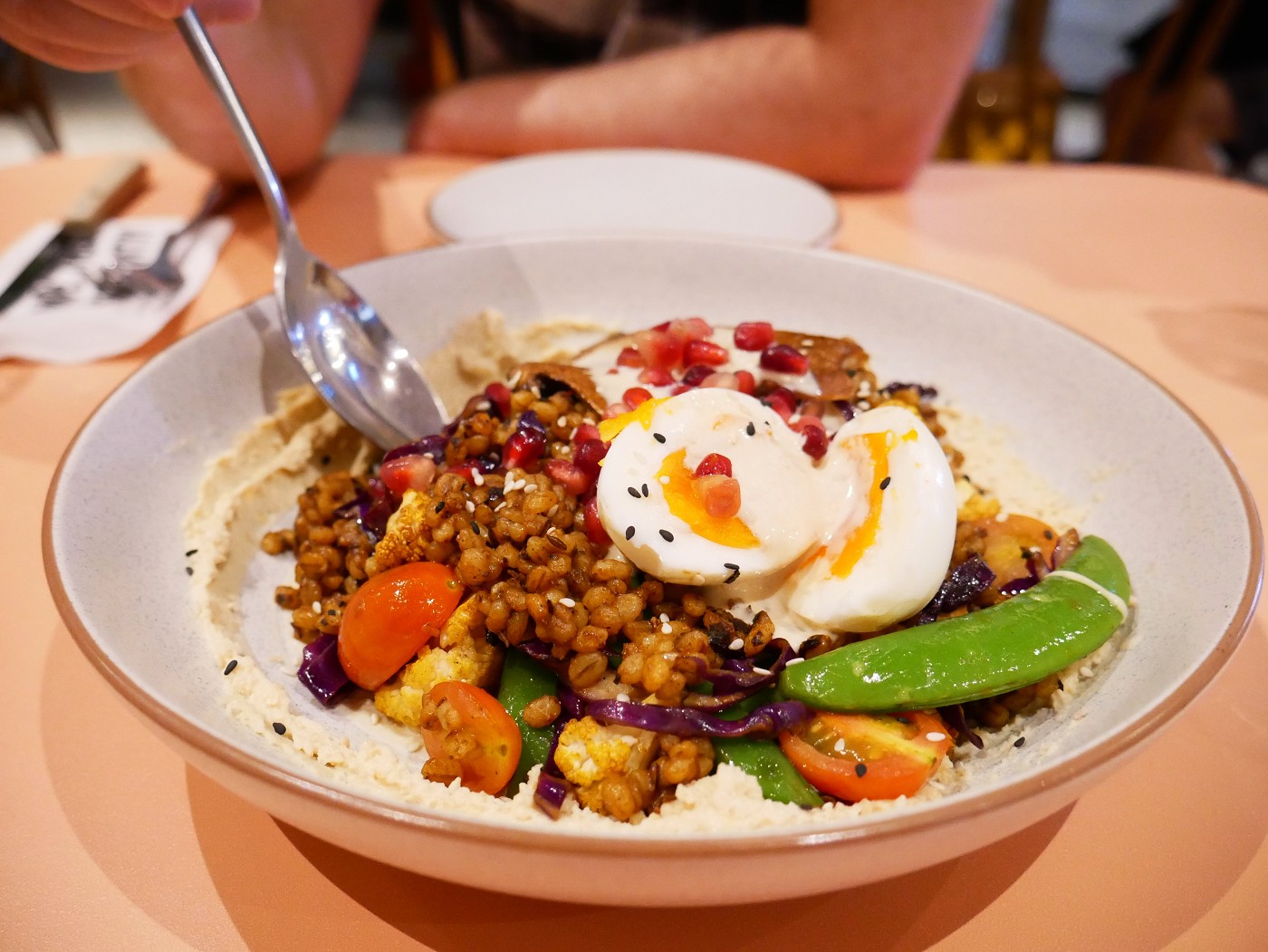
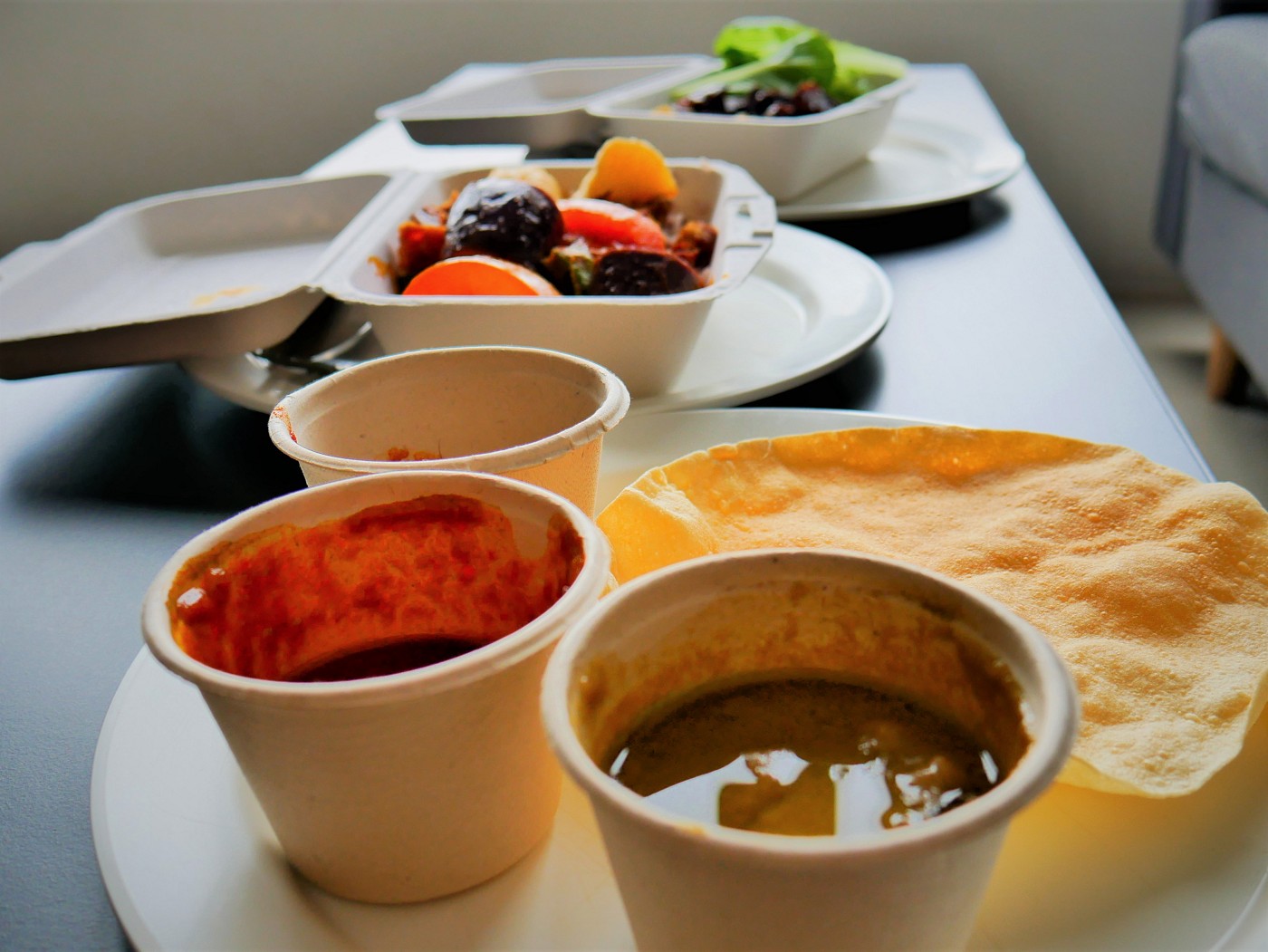
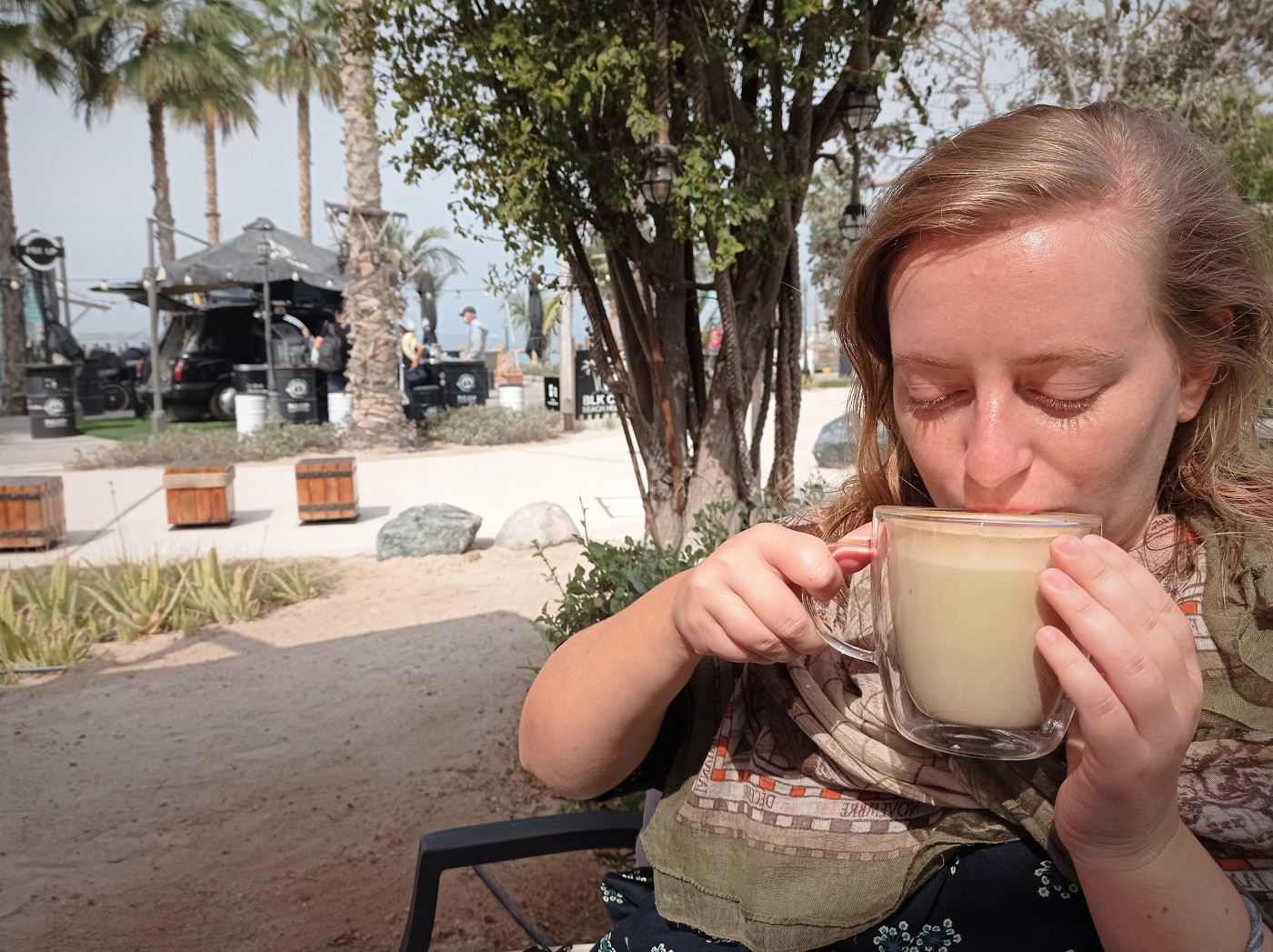
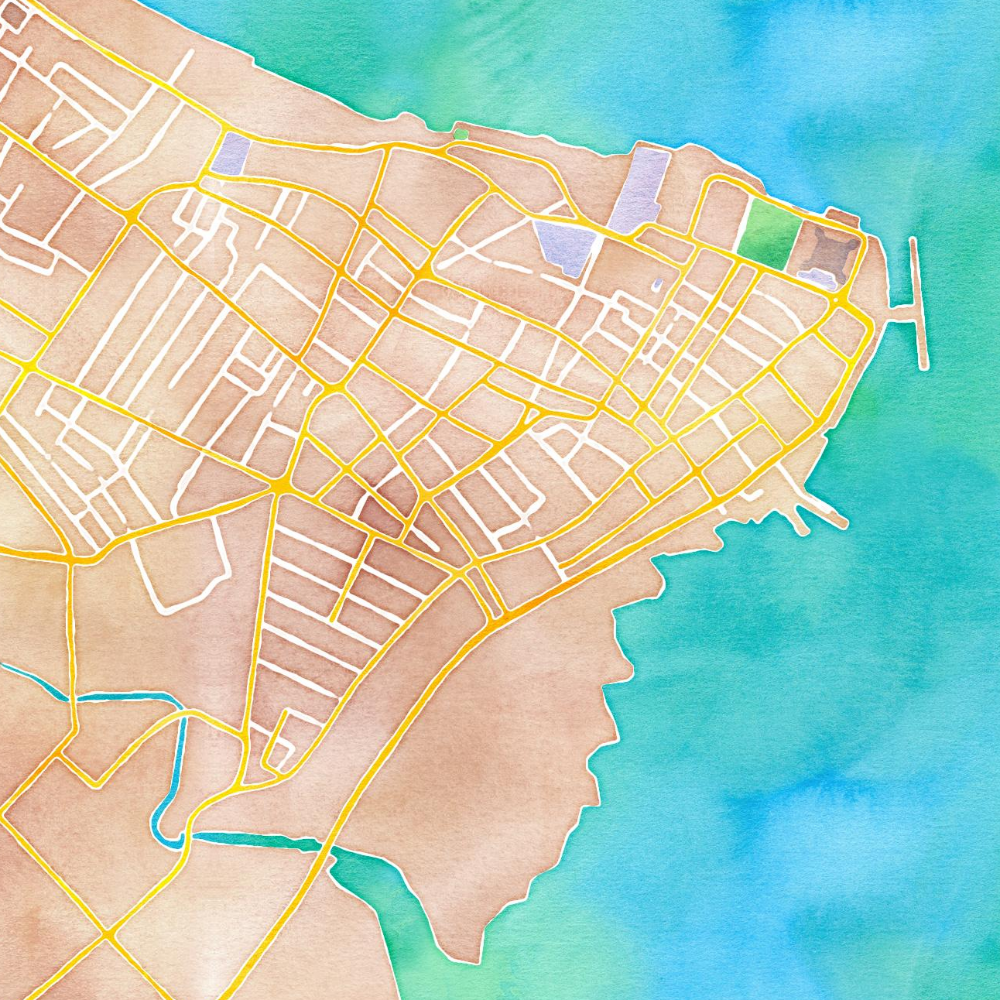
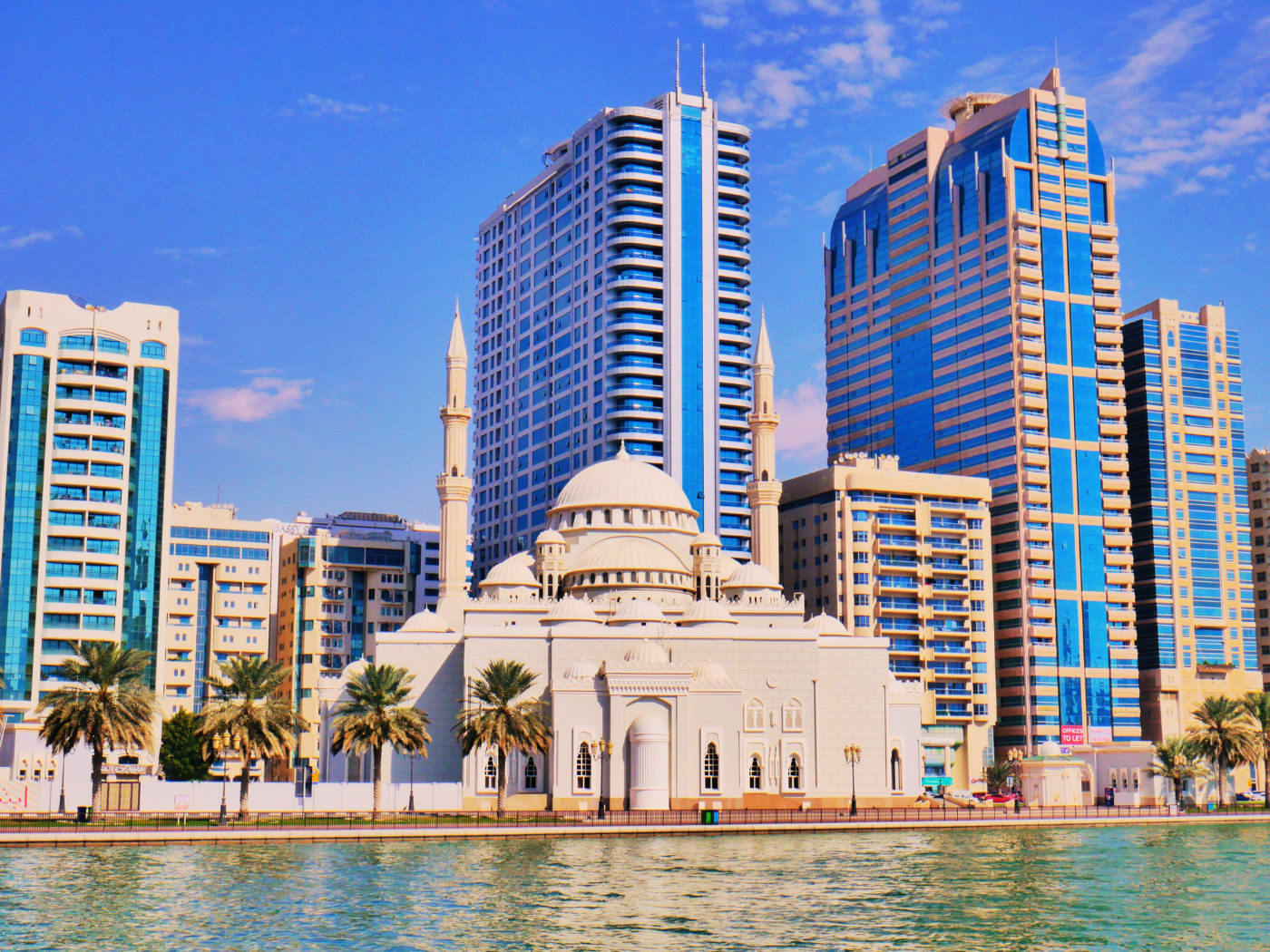
It was an interesting read , glad that you’ve experienced our food. However , there are corrections you need to make . One of the things is what you’ve mentioned about fish . Fish is not totally allowed during the fasting season , so not optional . The other thing is the fasting . There are seven fasting seasons . Orthodox Chritians who are seven years of old and above are required to do all the fasting . It’s not only the great lent which is of important to us . Last but not least , I advice you to triangulate information provided by your tour guides or whoever before you publish them .To me I would say it was a stab at the back . I hope you’ll address the issues! Other than that we are really greatful for promoting our cultural heritages !
Thank you for your more detailed explanation. These are nuances that go beyond the experiences of the average tourist
Absolutely that is amazing and healthy food ever in our 🌎
You have Very well explored and brought it to readers Ethiopian culture. Great experience.
Happy you liked it!